Tour Operations Management
VerifiedAdded on 2023/02/02
|9
|2423
|72
AI Summary
This document provides an overview of tour operations management in the travel industry. It covers topics such as brochure design, alternative advertising methods, distribution channels, strategic decisions, and tactical decisions. The document also includes case studies and examples from LCB Tours company.
Contribute Materials
Your contribution can guide someone’s learning journey. Share your
documents today.
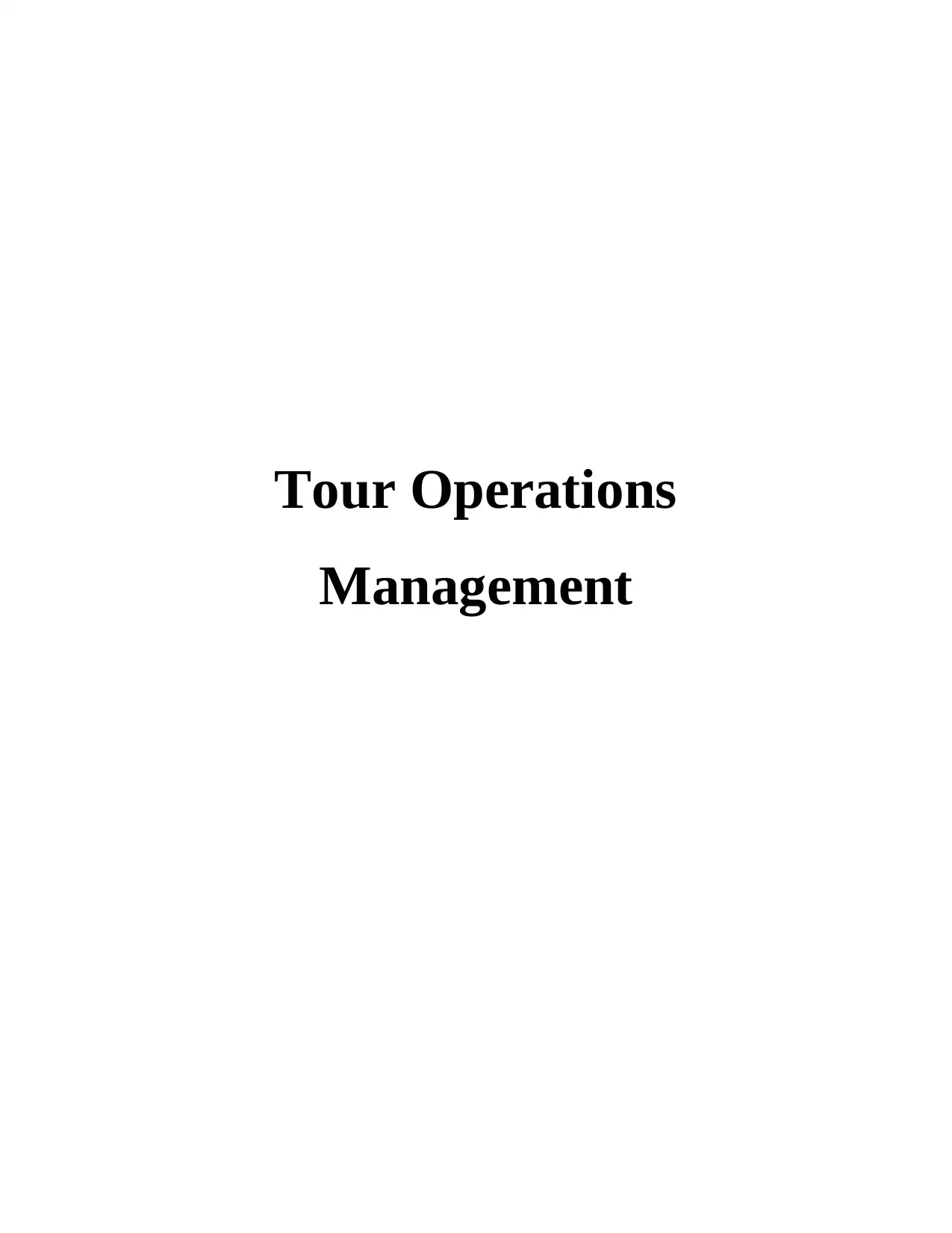
Tour Operations
Management
Management
Secure Best Marks with AI Grader
Need help grading? Try our AI Grader for instant feedback on your assignments.
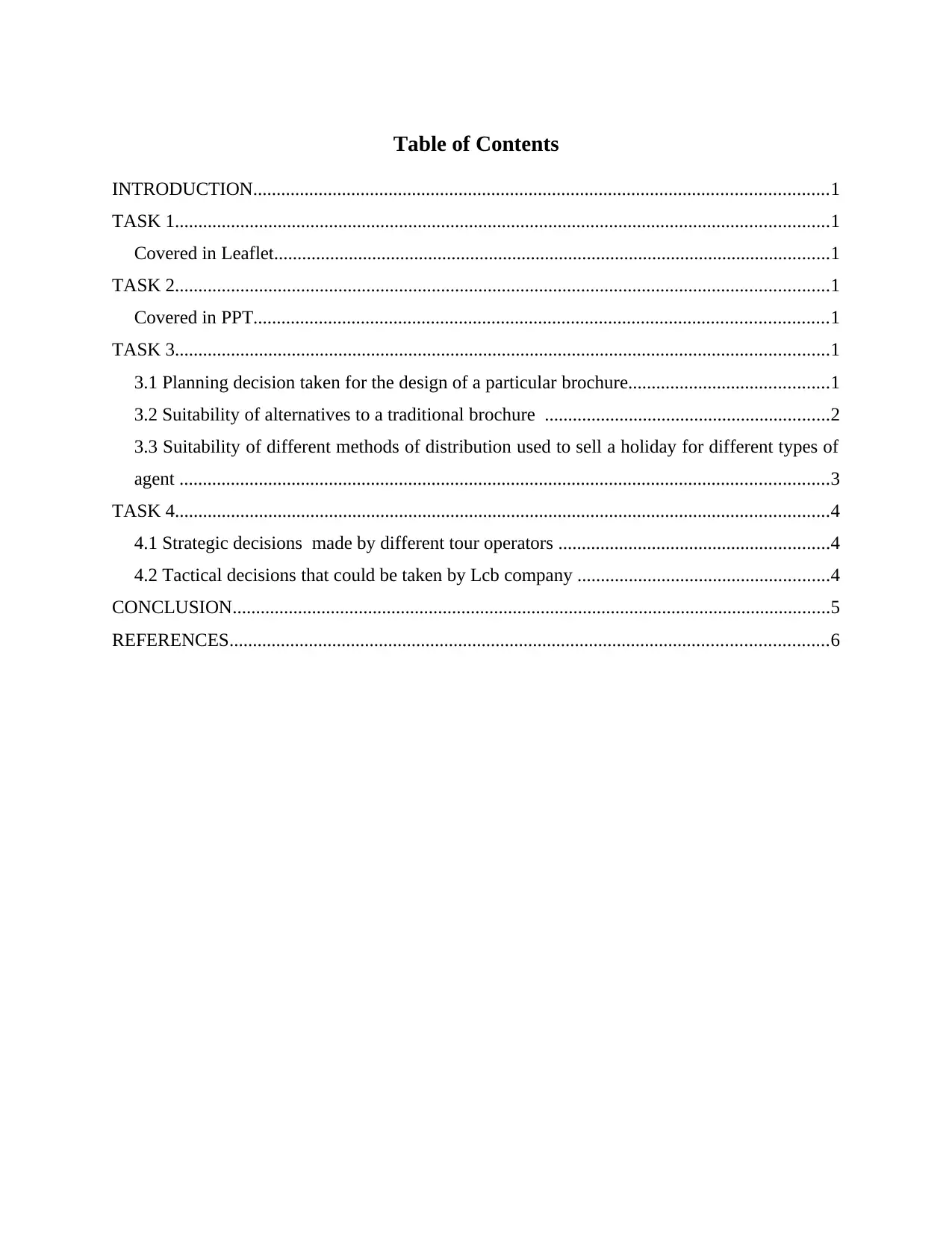
Table of Contents
INTRODUCTION...........................................................................................................................1
TASK 1............................................................................................................................................1
Covered in Leaflet.......................................................................................................................1
TASK 2............................................................................................................................................1
Covered in PPT...........................................................................................................................1
TASK 3............................................................................................................................................1
3.1 Planning decision taken for the design of a particular brochure...........................................1
3.2 Suitability of alternatives to a traditional brochure .............................................................2
3.3 Suitability of different methods of distribution used to sell a holiday for different types of
agent ...........................................................................................................................................3
TASK 4............................................................................................................................................4
4.1 Strategic decisions made by different tour operators ..........................................................4
4.2 Tactical decisions that could be taken by Lcb company ......................................................4
CONCLUSION................................................................................................................................5
REFERENCES................................................................................................................................6
INTRODUCTION...........................................................................................................................1
TASK 1............................................................................................................................................1
Covered in Leaflet.......................................................................................................................1
TASK 2............................................................................................................................................1
Covered in PPT...........................................................................................................................1
TASK 3............................................................................................................................................1
3.1 Planning decision taken for the design of a particular brochure...........................................1
3.2 Suitability of alternatives to a traditional brochure .............................................................2
3.3 Suitability of different methods of distribution used to sell a holiday for different types of
agent ...........................................................................................................................................3
TASK 4............................................................................................................................................4
4.1 Strategic decisions made by different tour operators ..........................................................4
4.2 Tactical decisions that could be taken by Lcb company ......................................................4
CONCLUSION................................................................................................................................5
REFERENCES................................................................................................................................6

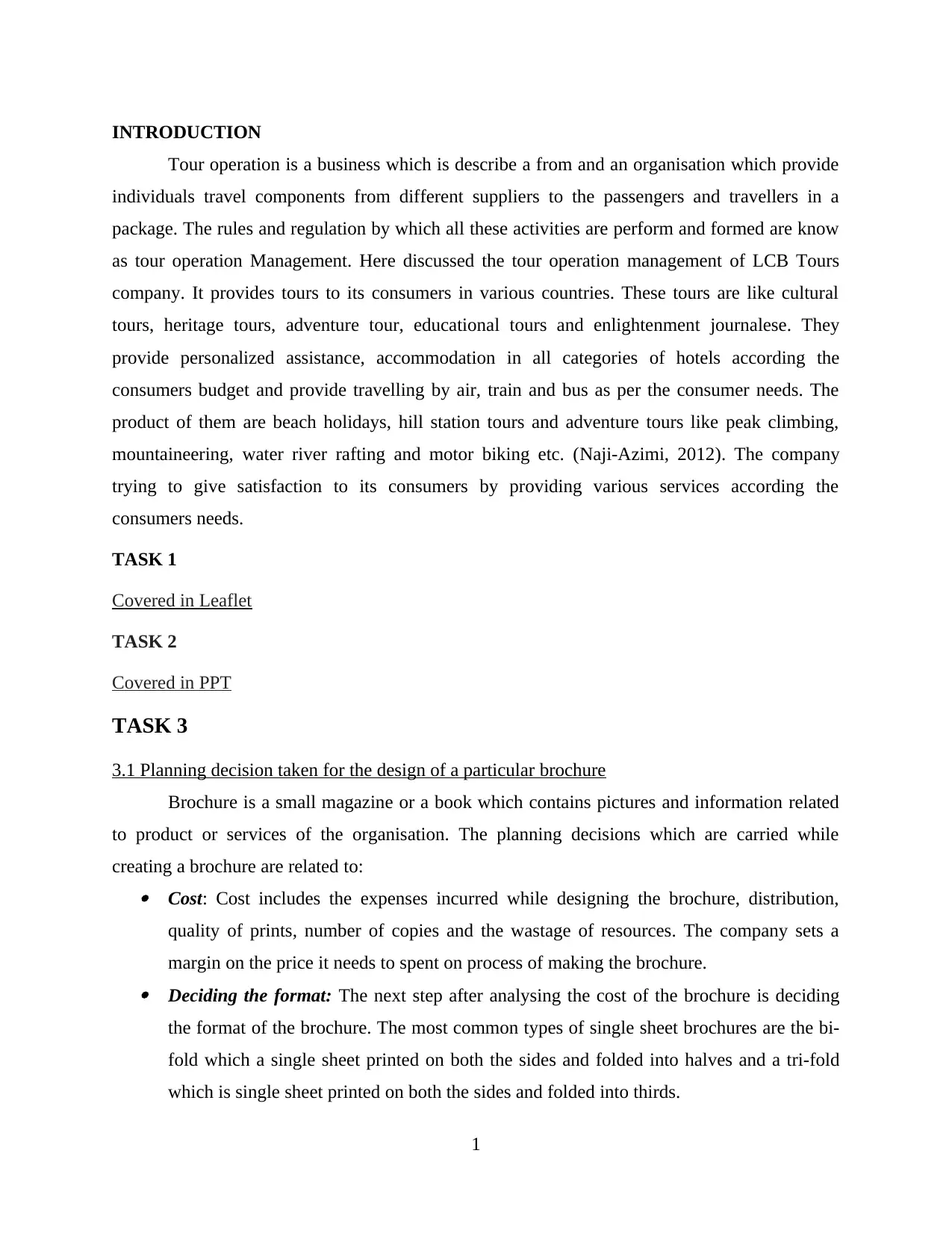
INTRODUCTION
Tour operation is a business which is describe a from and an organisation which provide
individuals travel components from different suppliers to the passengers and travellers in a
package. The rules and regulation by which all these activities are perform and formed are know
as tour operation Management. Here discussed the tour operation management of LCB Tours
company. It provides tours to its consumers in various countries. These tours are like cultural
tours, heritage tours, adventure tour, educational tours and enlightenment journalese. They
provide personalized assistance, accommodation in all categories of hotels according the
consumers budget and provide travelling by air, train and bus as per the consumer needs. The
product of them are beach holidays, hill station tours and adventure tours like peak climbing,
mountaineering, water river rafting and motor biking etc. (Naji-Azimi, 2012). The company
trying to give satisfaction to its consumers by providing various services according the
consumers needs.
TASK 1
Covered in Leaflet
TASK 2
Covered in PPT
TASK 3
3.1 Planning decision taken for the design of a particular brochure
Brochure is a small magazine or a book which contains pictures and information related
to product or services of the organisation. The planning decisions which are carried while
creating a brochure are related to: Cost: Cost includes the expenses incurred while designing the brochure, distribution,
quality of prints, number of copies and the wastage of resources. The company sets a
margin on the price it needs to spent on process of making the brochure. Deciding the format: The next step after analysing the cost of the brochure is deciding
the format of the brochure. The most common types of single sheet brochures are the bi-
fold which a single sheet printed on both the sides and folded into halves and a tri-fold
which is single sheet printed on both the sides and folded into thirds.
1
Tour operation is a business which is describe a from and an organisation which provide
individuals travel components from different suppliers to the passengers and travellers in a
package. The rules and regulation by which all these activities are perform and formed are know
as tour operation Management. Here discussed the tour operation management of LCB Tours
company. It provides tours to its consumers in various countries. These tours are like cultural
tours, heritage tours, adventure tour, educational tours and enlightenment journalese. They
provide personalized assistance, accommodation in all categories of hotels according the
consumers budget and provide travelling by air, train and bus as per the consumer needs. The
product of them are beach holidays, hill station tours and adventure tours like peak climbing,
mountaineering, water river rafting and motor biking etc. (Naji-Azimi, 2012). The company
trying to give satisfaction to its consumers by providing various services according the
consumers needs.
TASK 1
Covered in Leaflet
TASK 2
Covered in PPT
TASK 3
3.1 Planning decision taken for the design of a particular brochure
Brochure is a small magazine or a book which contains pictures and information related
to product or services of the organisation. The planning decisions which are carried while
creating a brochure are related to: Cost: Cost includes the expenses incurred while designing the brochure, distribution,
quality of prints, number of copies and the wastage of resources. The company sets a
margin on the price it needs to spent on process of making the brochure. Deciding the format: The next step after analysing the cost of the brochure is deciding
the format of the brochure. The most common types of single sheet brochures are the bi-
fold which a single sheet printed on both the sides and folded into halves and a tri-fold
which is single sheet printed on both the sides and folded into thirds.
1
Secure Best Marks with AI Grader
Need help grading? Try our AI Grader for instant feedback on your assignments.
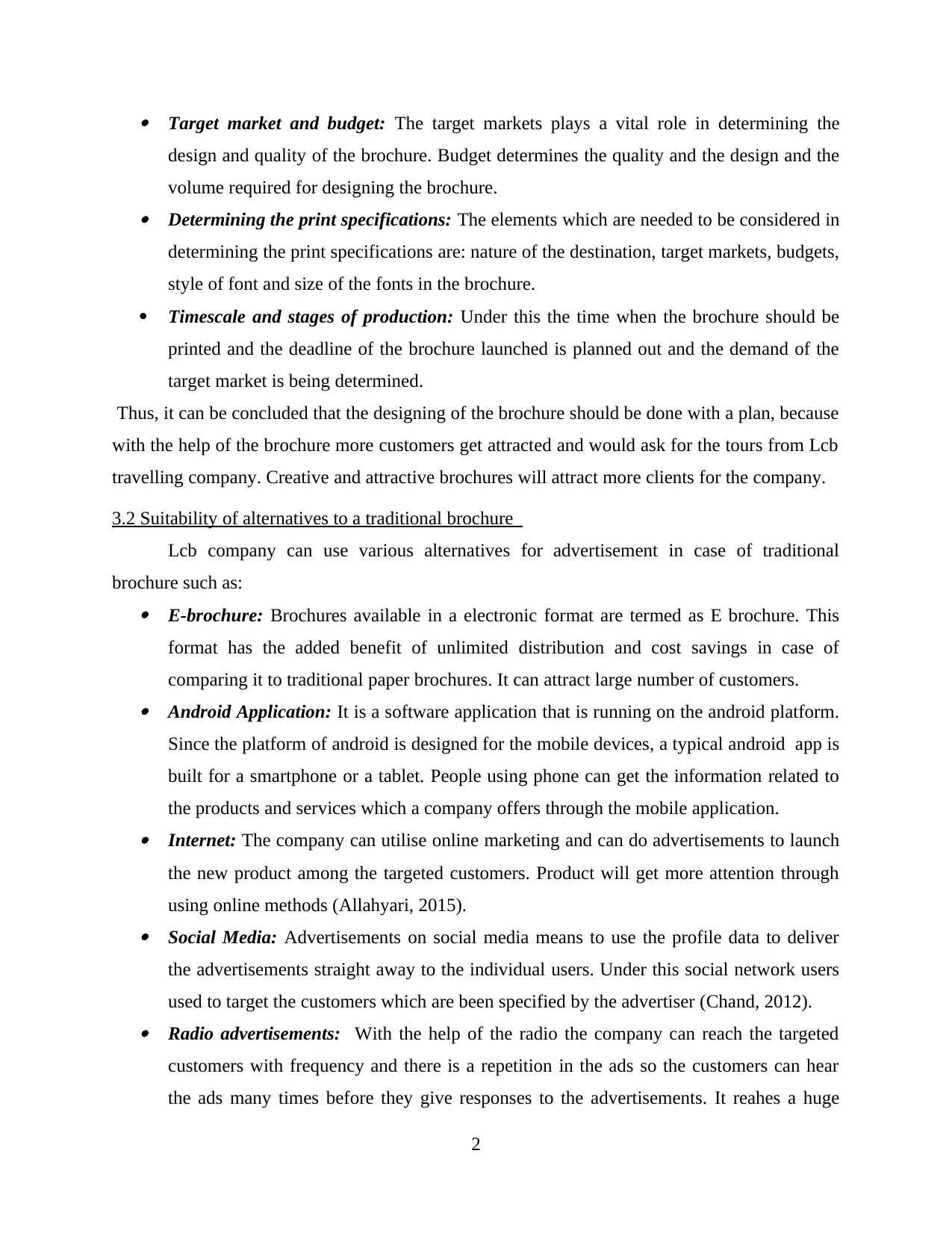
Target market and budget: The target markets plays a vital role in determining the
design and quality of the brochure. Budget determines the quality and the design and the
volume required for designing the brochure. Determining the print specifications: The elements which are needed to be considered in
determining the print specifications are: nature of the destination, target markets, budgets,
style of font and size of the fonts in the brochure.
Timescale and stages of production: Under this the time when the brochure should be
printed and the deadline of the brochure launched is planned out and the demand of the
target market is being determined.
Thus, it can be concluded that the designing of the brochure should be done with a plan, because
with the help of the brochure more customers get attracted and would ask for the tours from Lcb
travelling company. Creative and attractive brochures will attract more clients for the company.
3.2 Suitability of alternatives to a traditional brochure
Lcb company can use various alternatives for advertisement in case of traditional
brochure such as: E-brochure: Brochures available in a electronic format are termed as E brochure. This
format has the added benefit of unlimited distribution and cost savings in case of
comparing it to traditional paper brochures. It can attract large number of customers. Android Application: It is a software application that is running on the android platform.
Since the platform of android is designed for the mobile devices, a typical android app is
built for a smartphone or a tablet. People using phone can get the information related to
the products and services which a company offers through the mobile application. Internet: The company can utilise online marketing and can do advertisements to launch
the new product among the targeted customers. Product will get more attention through
using online methods (Allahyari, 2015). Social Media: Advertisements on social media means to use the profile data to deliver
the advertisements straight away to the individual users. Under this social network users
used to target the customers which are been specified by the advertiser (Chand, 2012). Radio advertisements: With the help of the radio the company can reach the targeted
customers with frequency and there is a repetition in the ads so the customers can hear
the ads many times before they give responses to the advertisements. It reahes a huge
2
design and quality of the brochure. Budget determines the quality and the design and the
volume required for designing the brochure. Determining the print specifications: The elements which are needed to be considered in
determining the print specifications are: nature of the destination, target markets, budgets,
style of font and size of the fonts in the brochure.
Timescale and stages of production: Under this the time when the brochure should be
printed and the deadline of the brochure launched is planned out and the demand of the
target market is being determined.
Thus, it can be concluded that the designing of the brochure should be done with a plan, because
with the help of the brochure more customers get attracted and would ask for the tours from Lcb
travelling company. Creative and attractive brochures will attract more clients for the company.
3.2 Suitability of alternatives to a traditional brochure
Lcb company can use various alternatives for advertisement in case of traditional
brochure such as: E-brochure: Brochures available in a electronic format are termed as E brochure. This
format has the added benefit of unlimited distribution and cost savings in case of
comparing it to traditional paper brochures. It can attract large number of customers. Android Application: It is a software application that is running on the android platform.
Since the platform of android is designed for the mobile devices, a typical android app is
built for a smartphone or a tablet. People using phone can get the information related to
the products and services which a company offers through the mobile application. Internet: The company can utilise online marketing and can do advertisements to launch
the new product among the targeted customers. Product will get more attention through
using online methods (Allahyari, 2015). Social Media: Advertisements on social media means to use the profile data to deliver
the advertisements straight away to the individual users. Under this social network users
used to target the customers which are been specified by the advertiser (Chand, 2012). Radio advertisements: With the help of the radio the company can reach the targeted
customers with frequency and there is a repetition in the ads so the customers can hear
the ads many times before they give responses to the advertisements. It reahes a huge
2
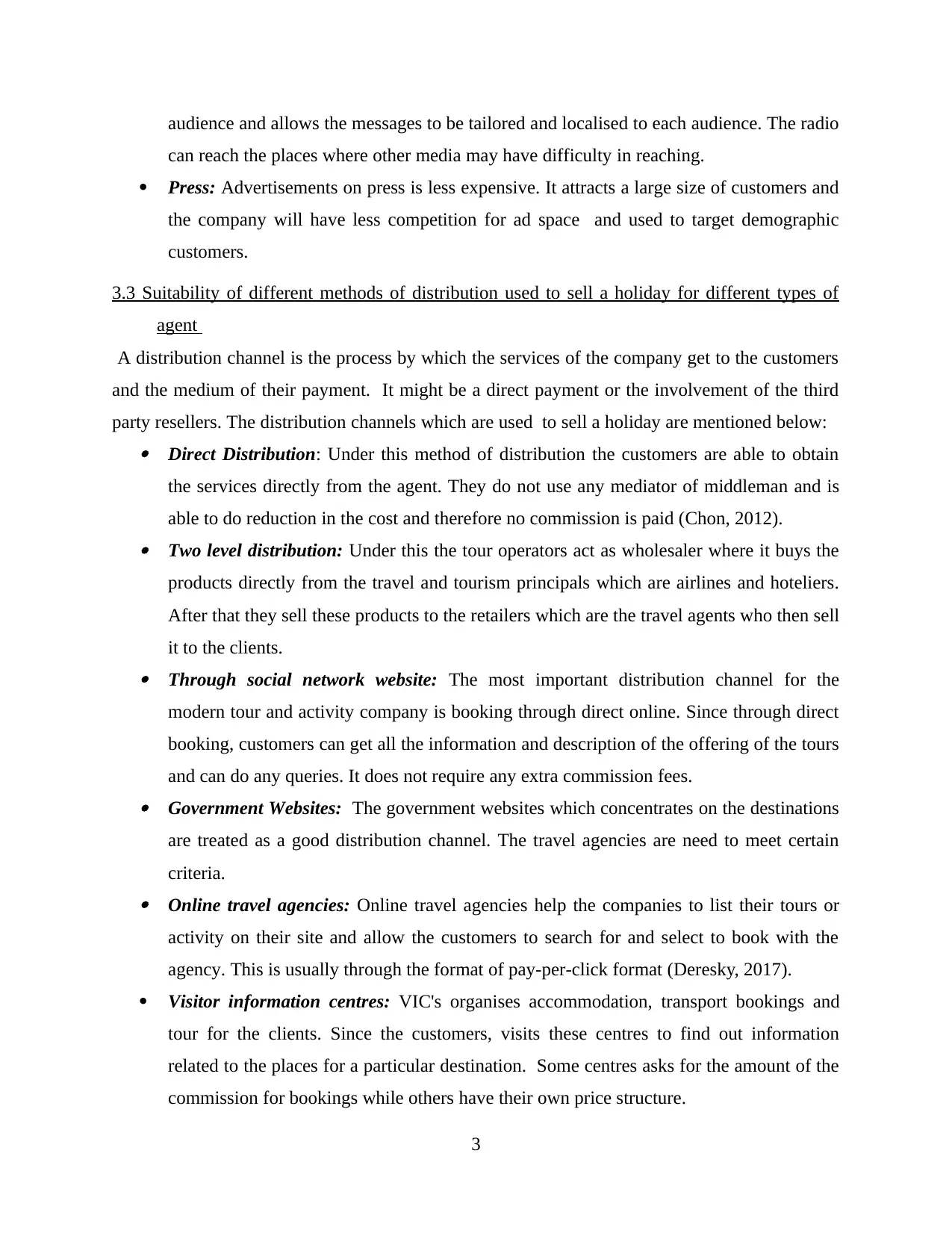
audience and allows the messages to be tailored and localised to each audience. The radio
can reach the places where other media may have difficulty in reaching.
Press: Advertisements on press is less expensive. It attracts a large size of customers and
the company will have less competition for ad space and used to target demographic
customers.
3.3 Suitability of different methods of distribution used to sell a holiday for different types of
agent
A distribution channel is the process by which the services of the company get to the customers
and the medium of their payment. It might be a direct payment or the involvement of the third
party resellers. The distribution channels which are used to sell a holiday are mentioned below: Direct Distribution: Under this method of distribution the customers are able to obtain
the services directly from the agent. They do not use any mediator of middleman and is
able to do reduction in the cost and therefore no commission is paid (Chon, 2012). Two level distribution: Under this the tour operators act as wholesaler where it buys the
products directly from the travel and tourism principals which are airlines and hoteliers.
After that they sell these products to the retailers which are the travel agents who then sell
it to the clients. Through social network website: The most important distribution channel for the
modern tour and activity company is booking through direct online. Since through direct
booking, customers can get all the information and description of the offering of the tours
and can do any queries. It does not require any extra commission fees. Government Websites: The government websites which concentrates on the destinations
are treated as a good distribution channel. The travel agencies are need to meet certain
criteria. Online travel agencies: Online travel agencies help the companies to list their tours or
activity on their site and allow the customers to search for and select to book with the
agency. This is usually through the format of pay-per-click format (Deresky, 2017).
Visitor information centres: VIC's organises accommodation, transport bookings and
tour for the clients. Since the customers, visits these centres to find out information
related to the places for a particular destination. Some centres asks for the amount of the
commission for bookings while others have their own price structure.
3
can reach the places where other media may have difficulty in reaching.
Press: Advertisements on press is less expensive. It attracts a large size of customers and
the company will have less competition for ad space and used to target demographic
customers.
3.3 Suitability of different methods of distribution used to sell a holiday for different types of
agent
A distribution channel is the process by which the services of the company get to the customers
and the medium of their payment. It might be a direct payment or the involvement of the third
party resellers. The distribution channels which are used to sell a holiday are mentioned below: Direct Distribution: Under this method of distribution the customers are able to obtain
the services directly from the agent. They do not use any mediator of middleman and is
able to do reduction in the cost and therefore no commission is paid (Chon, 2012). Two level distribution: Under this the tour operators act as wholesaler where it buys the
products directly from the travel and tourism principals which are airlines and hoteliers.
After that they sell these products to the retailers which are the travel agents who then sell
it to the clients. Through social network website: The most important distribution channel for the
modern tour and activity company is booking through direct online. Since through direct
booking, customers can get all the information and description of the offering of the tours
and can do any queries. It does not require any extra commission fees. Government Websites: The government websites which concentrates on the destinations
are treated as a good distribution channel. The travel agencies are need to meet certain
criteria. Online travel agencies: Online travel agencies help the companies to list their tours or
activity on their site and allow the customers to search for and select to book with the
agency. This is usually through the format of pay-per-click format (Deresky, 2017).
Visitor information centres: VIC's organises accommodation, transport bookings and
tour for the clients. Since the customers, visits these centres to find out information
related to the places for a particular destination. Some centres asks for the amount of the
commission for bookings while others have their own price structure.
3
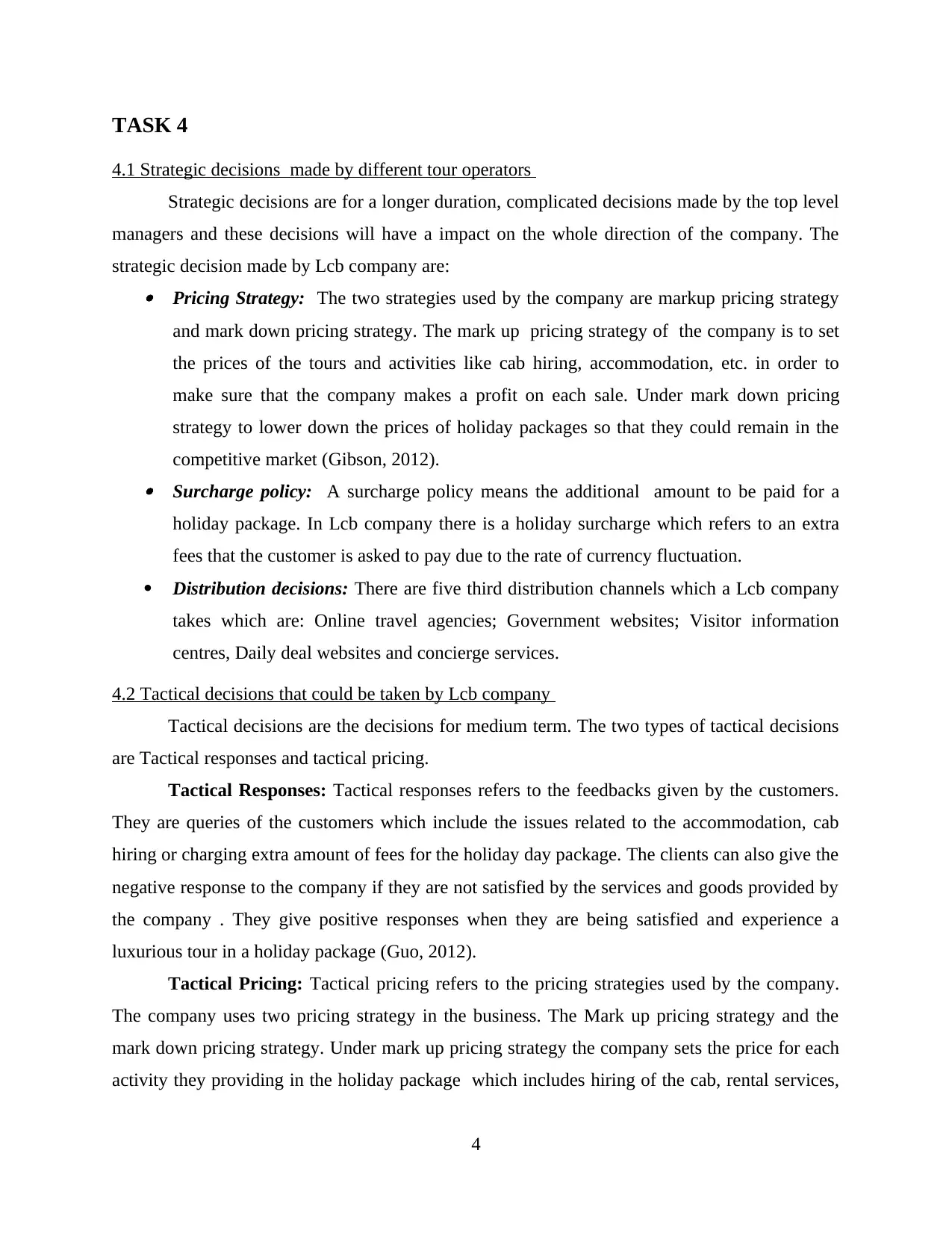
TASK 4
4.1 Strategic decisions made by different tour operators
Strategic decisions are for a longer duration, complicated decisions made by the top level
managers and these decisions will have a impact on the whole direction of the company. The
strategic decision made by Lcb company are: Pricing Strategy: The two strategies used by the company are markup pricing strategy
and mark down pricing strategy. The mark up pricing strategy of the company is to set
the prices of the tours and activities like cab hiring, accommodation, etc. in order to
make sure that the company makes a profit on each sale. Under mark down pricing
strategy to lower down the prices of holiday packages so that they could remain in the
competitive market (Gibson, 2012). Surcharge policy: A surcharge policy means the additional amount to be paid for a
holiday package. In Lcb company there is a holiday surcharge which refers to an extra
fees that the customer is asked to pay due to the rate of currency fluctuation.
Distribution decisions: There are five third distribution channels which a Lcb company
takes which are: Online travel agencies; Government websites; Visitor information
centres, Daily deal websites and concierge services.
4.2 Tactical decisions that could be taken by Lcb company
Tactical decisions are the decisions for medium term. The two types of tactical decisions
are Tactical responses and tactical pricing.
Tactical Responses: Tactical responses refers to the feedbacks given by the customers.
They are queries of the customers which include the issues related to the accommodation, cab
hiring or charging extra amount of fees for the holiday day package. The clients can also give the
negative response to the company if they are not satisfied by the services and goods provided by
the company . They give positive responses when they are being satisfied and experience a
luxurious tour in a holiday package (Guo, 2012).
Tactical Pricing: Tactical pricing refers to the pricing strategies used by the company.
The company uses two pricing strategy in the business. The Mark up pricing strategy and the
mark down pricing strategy. Under mark up pricing strategy the company sets the price for each
activity they providing in the holiday package which includes hiring of the cab, rental services,
4
4.1 Strategic decisions made by different tour operators
Strategic decisions are for a longer duration, complicated decisions made by the top level
managers and these decisions will have a impact on the whole direction of the company. The
strategic decision made by Lcb company are: Pricing Strategy: The two strategies used by the company are markup pricing strategy
and mark down pricing strategy. The mark up pricing strategy of the company is to set
the prices of the tours and activities like cab hiring, accommodation, etc. in order to
make sure that the company makes a profit on each sale. Under mark down pricing
strategy to lower down the prices of holiday packages so that they could remain in the
competitive market (Gibson, 2012). Surcharge policy: A surcharge policy means the additional amount to be paid for a
holiday package. In Lcb company there is a holiday surcharge which refers to an extra
fees that the customer is asked to pay due to the rate of currency fluctuation.
Distribution decisions: There are five third distribution channels which a Lcb company
takes which are: Online travel agencies; Government websites; Visitor information
centres, Daily deal websites and concierge services.
4.2 Tactical decisions that could be taken by Lcb company
Tactical decisions are the decisions for medium term. The two types of tactical decisions
are Tactical responses and tactical pricing.
Tactical Responses: Tactical responses refers to the feedbacks given by the customers.
They are queries of the customers which include the issues related to the accommodation, cab
hiring or charging extra amount of fees for the holiday day package. The clients can also give the
negative response to the company if they are not satisfied by the services and goods provided by
the company . They give positive responses when they are being satisfied and experience a
luxurious tour in a holiday package (Guo, 2012).
Tactical Pricing: Tactical pricing refers to the pricing strategies used by the company.
The company uses two pricing strategy in the business. The Mark up pricing strategy and the
mark down pricing strategy. Under mark up pricing strategy the company sets the price for each
activity they providing in the holiday package which includes hiring of the cab, rental services,
4
Paraphrase This Document
Need a fresh take? Get an instant paraphrase of this document with our AI Paraphraser
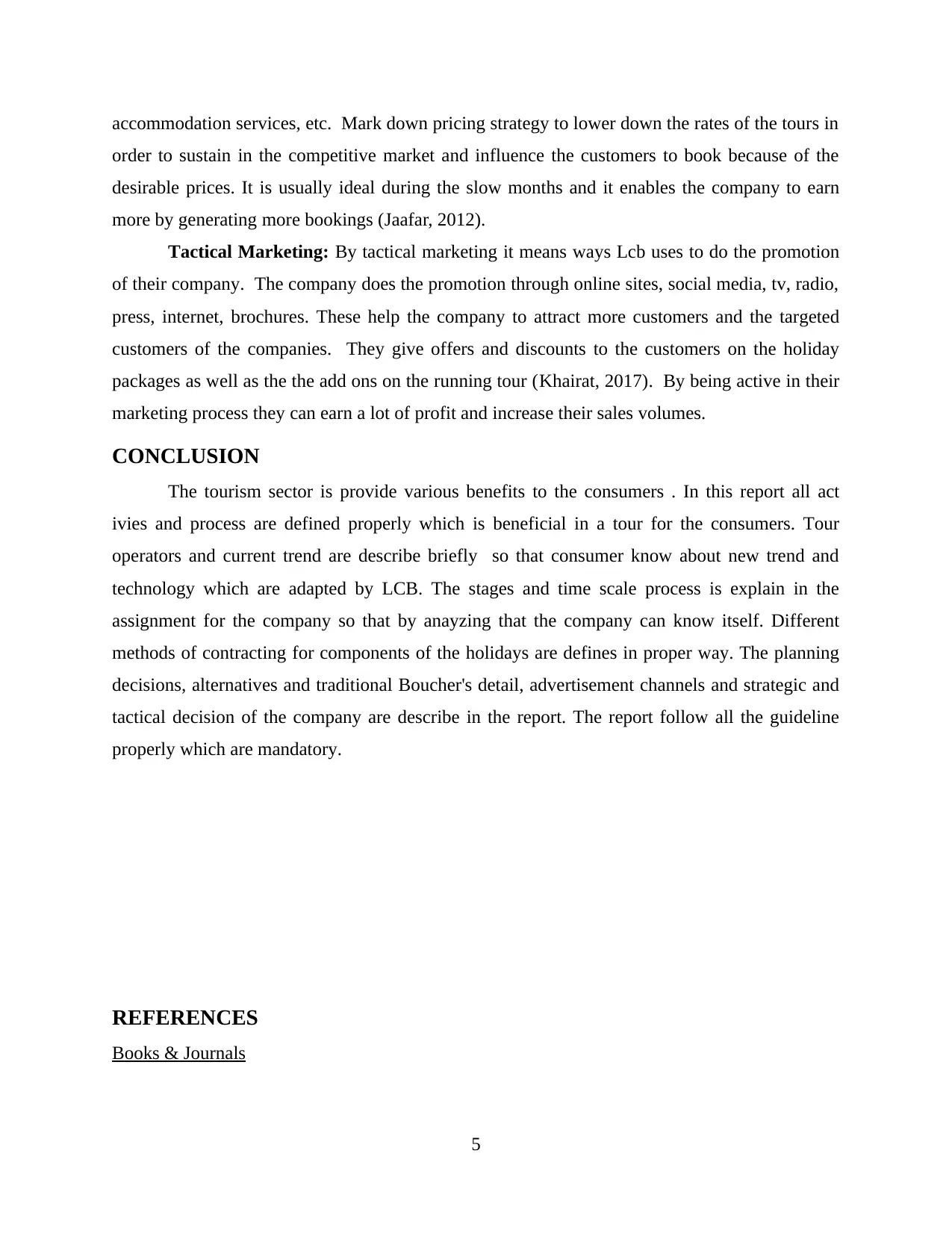
accommodation services, etc. Mark down pricing strategy to lower down the rates of the tours in
order to sustain in the competitive market and influence the customers to book because of the
desirable prices. It is usually ideal during the slow months and it enables the company to earn
more by generating more bookings (Jaafar, 2012).
Tactical Marketing: By tactical marketing it means ways Lcb uses to do the promotion
of their company. The company does the promotion through online sites, social media, tv, radio,
press, internet, brochures. These help the company to attract more customers and the targeted
customers of the companies. They give offers and discounts to the customers on the holiday
packages as well as the the add ons on the running tour (Khairat, 2017). By being active in their
marketing process they can earn a lot of profit and increase their sales volumes.
CONCLUSION
The tourism sector is provide various benefits to the consumers . In this report all act
ivies and process are defined properly which is beneficial in a tour for the consumers. Tour
operators and current trend are describe briefly so that consumer know about new trend and
technology which are adapted by LCB. The stages and time scale process is explain in the
assignment for the company so that by anayzing that the company can know itself. Different
methods of contracting for components of the holidays are defines in proper way. The planning
decisions, alternatives and traditional Boucher's detail, advertisement channels and strategic and
tactical decision of the company are describe in the report. The report follow all the guideline
properly which are mandatory.
REFERENCES
Books & Journals
5
order to sustain in the competitive market and influence the customers to book because of the
desirable prices. It is usually ideal during the slow months and it enables the company to earn
more by generating more bookings (Jaafar, 2012).
Tactical Marketing: By tactical marketing it means ways Lcb uses to do the promotion
of their company. The company does the promotion through online sites, social media, tv, radio,
press, internet, brochures. These help the company to attract more customers and the targeted
customers of the companies. They give offers and discounts to the customers on the holiday
packages as well as the the add ons on the running tour (Khairat, 2017). By being active in their
marketing process they can earn a lot of profit and increase their sales volumes.
CONCLUSION
The tourism sector is provide various benefits to the consumers . In this report all act
ivies and process are defined properly which is beneficial in a tour for the consumers. Tour
operators and current trend are describe briefly so that consumer know about new trend and
technology which are adapted by LCB. The stages and time scale process is explain in the
assignment for the company so that by anayzing that the company can know itself. Different
methods of contracting for components of the holidays are defines in proper way. The planning
decisions, alternatives and traditional Boucher's detail, advertisement channels and strategic and
tactical decision of the company are describe in the report. The report follow all the guideline
properly which are mandatory.
REFERENCES
Books & Journals
5
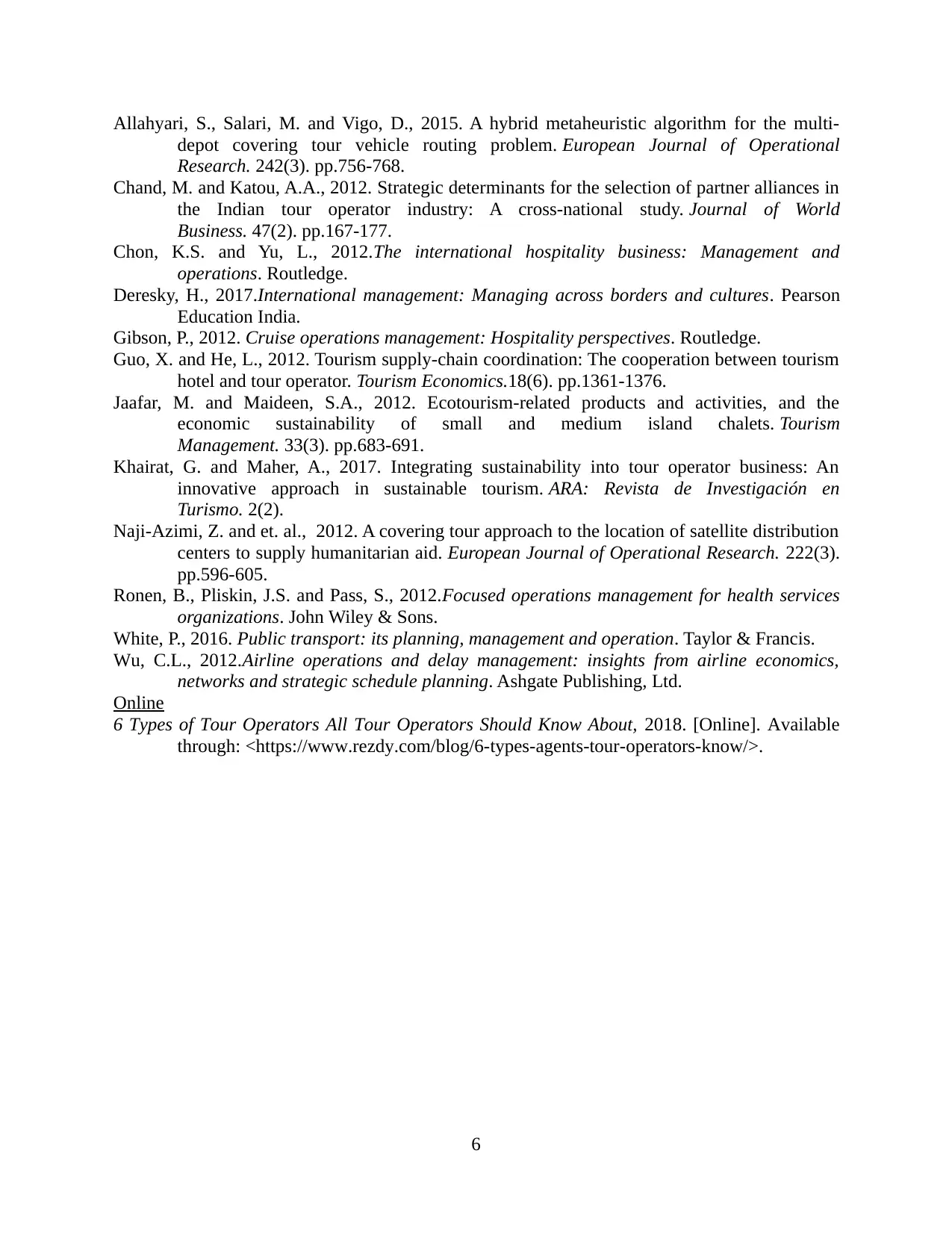
Allahyari, S., Salari, M. and Vigo, D., 2015. A hybrid metaheuristic algorithm for the multi-
depot covering tour vehicle routing problem. European Journal of Operational
Research. 242(3). pp.756-768.
Chand, M. and Katou, A.A., 2012. Strategic determinants for the selection of partner alliances in
the Indian tour operator industry: A cross-national study. Journal of World
Business. 47(2). pp.167-177.
Chon, K.S. and Yu, L., 2012.The international hospitality business: Management and
operations. Routledge.
Deresky, H., 2017.International management: Managing across borders and cultures. Pearson
Education India.
Gibson, P., 2012. Cruise operations management: Hospitality perspectives. Routledge.
Guo, X. and He, L., 2012. Tourism supply-chain coordination: The cooperation between tourism
hotel and tour operator. Tourism Economics.18(6). pp.1361-1376.
Jaafar, M. and Maideen, S.A., 2012. Ecotourism-related products and activities, and the
economic sustainability of small and medium island chalets. Tourism
Management. 33(3). pp.683-691.
Khairat, G. and Maher, A., 2017. Integrating sustainability into tour operator business: An
innovative approach in sustainable tourism. ARA: Revista de Investigación en
Turismo. 2(2).
Naji-Azimi, Z. and et. al., 2012. A covering tour approach to the location of satellite distribution
centers to supply humanitarian aid. European Journal of Operational Research. 222(3).
pp.596-605.
Ronen, B., Pliskin, J.S. and Pass, S., 2012.Focused operations management for health services
organizations. John Wiley & Sons.
White, P., 2016. Public transport: its planning, management and operation. Taylor & Francis.
Wu, C.L., 2012.Airline operations and delay management: insights from airline economics,
networks and strategic schedule planning. Ashgate Publishing, Ltd.
Online
6 Types of Tour Operators All Tour Operators Should Know About, 2018. [Online]. Available
through: <https://www.rezdy.com/blog/6-types-agents-tour-operators-know/>.
6
depot covering tour vehicle routing problem. European Journal of Operational
Research. 242(3). pp.756-768.
Chand, M. and Katou, A.A., 2012. Strategic determinants for the selection of partner alliances in
the Indian tour operator industry: A cross-national study. Journal of World
Business. 47(2). pp.167-177.
Chon, K.S. and Yu, L., 2012.The international hospitality business: Management and
operations. Routledge.
Deresky, H., 2017.International management: Managing across borders and cultures. Pearson
Education India.
Gibson, P., 2012. Cruise operations management: Hospitality perspectives. Routledge.
Guo, X. and He, L., 2012. Tourism supply-chain coordination: The cooperation between tourism
hotel and tour operator. Tourism Economics.18(6). pp.1361-1376.
Jaafar, M. and Maideen, S.A., 2012. Ecotourism-related products and activities, and the
economic sustainability of small and medium island chalets. Tourism
Management. 33(3). pp.683-691.
Khairat, G. and Maher, A., 2017. Integrating sustainability into tour operator business: An
innovative approach in sustainable tourism. ARA: Revista de Investigación en
Turismo. 2(2).
Naji-Azimi, Z. and et. al., 2012. A covering tour approach to the location of satellite distribution
centers to supply humanitarian aid. European Journal of Operational Research. 222(3).
pp.596-605.
Ronen, B., Pliskin, J.S. and Pass, S., 2012.Focused operations management for health services
organizations. John Wiley & Sons.
White, P., 2016. Public transport: its planning, management and operation. Taylor & Francis.
Wu, C.L., 2012.Airline operations and delay management: insights from airline economics,
networks and strategic schedule planning. Ashgate Publishing, Ltd.
Online
6 Types of Tour Operators All Tour Operators Should Know About, 2018. [Online]. Available
through: <https://www.rezdy.com/blog/6-types-agents-tour-operators-know/>.
6
1 out of 9
Related Documents
Your All-in-One AI-Powered Toolkit for Academic Success.
+13062052269
info@desklib.com
Available 24*7 on WhatsApp / Email
![[object Object]](/_next/static/media/star-bottom.7253800d.svg)
Unlock your academic potential
© 2024 | Zucol Services PVT LTD | All rights reserved.





